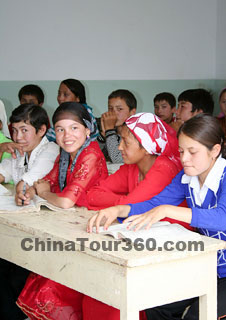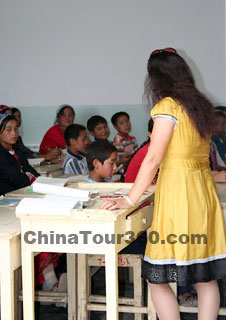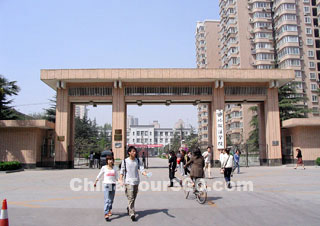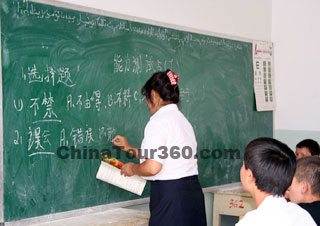Since 1949, when the People's Republic of China was founded, the government has always placed education high on its agenda. Through uninterrupted efforts over the past five decades, China has made significant progress. A nine-year compulsory education is being implemented in planned stages nationwide and primary schooling is now available to 91% of the Chinese population. Institutions of higher learning such as occupational polytechnic, diversified adult and ethical schools have also been developed rapidly.
 |
| Chinese Students in Xinjiang |
China has set up an educational system where government is the major investor and social partners are co-investors. In its current stage, local government is playing a key role in compulsory education, while central and provincial governments are dominant in higher learning. The Ministry of Education is responsible for carrying out the related laws, regulations, guidelines and policies of the central government. It is also in charge of planning the development of the education sector, integrating and coordinating initiatives and programs nationwide, and maneuvering and guiding reform countrywide. In recent years, non-government investment has been moving into the educational sector, providing more seats for more applicants.
Financial allocation is still the major source of the education budget. At present, funds needed by schools directly and controlled by the central government come from the central financial pool; schools controlled by local governments are supported by local finance etc. Other types of arrangements include schools sponsored by small town and village governments in combination with public institutions, which are mainly financed by the sponsor institutions and subsidized by local governments. As well, funds needed by schools operated by social partners and celebrities are raised by the sponsors themselves (including collecting tuition from students and soliciting contributions). In addition to these sources, the central government is advocating work-study programs, aiming at improving the education conditions through premium services.
 |
| A Class of Elementary School |
![]() Basic Education
Basic Education
Chinese government has always listed basic education as one of its top priorities. Since 1986, primary schooling has prevailed in most areas of China, while junior middle schooling is being to be implemented in large cities and economically developed areas. Up to 1999, there were 582,300 primary schools countrywide with an enrollment of 135.5 million and moderate development had been made in junior middle schooling. By 1999, there were 64,400 junior middle schools nationwide with admission of 21.8 million and enrollment of 58.1 million. In addition, there were 14,100 high schools nationwide with admission of 3,963,200 and enrollment of 10.54 million. In 1999, there were also 1,520 special schools opened for hearing impaired and mentally disabled children, with an enrollment of 371,600. More than half of the handicapped children had access to basic education. There were 181,110 kindergartens nationwide with an enrollment of 23.2 million.
![]() Medium-level Occupational and Polytechnic Education
Medium-level Occupational and Polytechnic Education
This section is mainly composed of medium-level professional schools, polytechnic schools, occupational middle schools and short-term occupational and technical training programs of various forms.
Up to 1997, there were 33,464 occupational and polytechnic schools nationwide with an enrollment of 18.7 million.
 |
| NorthWest University of Politics and Law |
It is comprised of junior college, bachelor, masters and doctoral degree programs. Junior college programs usually last two or three years; bachelor programs four years (medical and some engineering and technical programs, five years); masters programs two or three years; doctoral programs three years.
In last five decades, China has made significant achievements in higher learning. Through waves of reform and restructuring, higher education in the country has been vitalized. The scale has expanded structure upgraded and quality and efficiency improved, leading to a multilayered, diversified and discipline-inclusive higher education system.
Up to 1999, there were 1,071 common colleges and universities countrywide. These schools offered 2,754,500 seats to those applying for junior college and bachelor programs, 19,900 seats to those applying for doctoral programs and 72,300 seats to masters' program applicants.
In recent years, higher education is experiencing reform. Key moves have been made in the management system and layout restructuring of higher education. In 1999, the number of colleges and universities was 1,942, decreasing by 49 from the previous year. To compensate for this admission expansion of colleges and universities has been successfully implemented, leading to a significant increase in seats offered. This tendency will continue for the next few years.
![]() Adult Education
Adult Education
It comprises of schooling, anti-illiteracy education and other programs oriented to adult groups.
China's adult education has evolved rapidly since the Liberation. Up to 1999, there were 871 colleges and universities dedicated to adult education and 800 correspondence-based and evening programs at common colleges. These schools offered 1,157,700 seats to those pursuing junior college and bachelor programs, and granted diplomas to 888,200 people.

A Chinese Classroom
Adult 'higher learning institutes' include radio and TV universities, workers' colleges, farmers' colleges, correspondence colleges, evening universities, and colleges giving in-service training to government employees or secondary school teachers. 'Secondary schools' for adult education include vocational secondary schools, middle schools and technical training schools. 'Primary schools' for adult include workers' and farmers' primary schools and literacy classes.
![]() International Communication and Cooperation
International Communication and Cooperation
Since 1978, when China inaugurated the opening and reform initiative, international communication and cooperation in the education sector has migrated onto a new stage. The system is now cheering the development of study abroad programs, increasing the number of foreigners studying in China, and expanding cross-border academic communication. More and more universities are beginning to provide long and short-term studying programs for foreign students in China.







